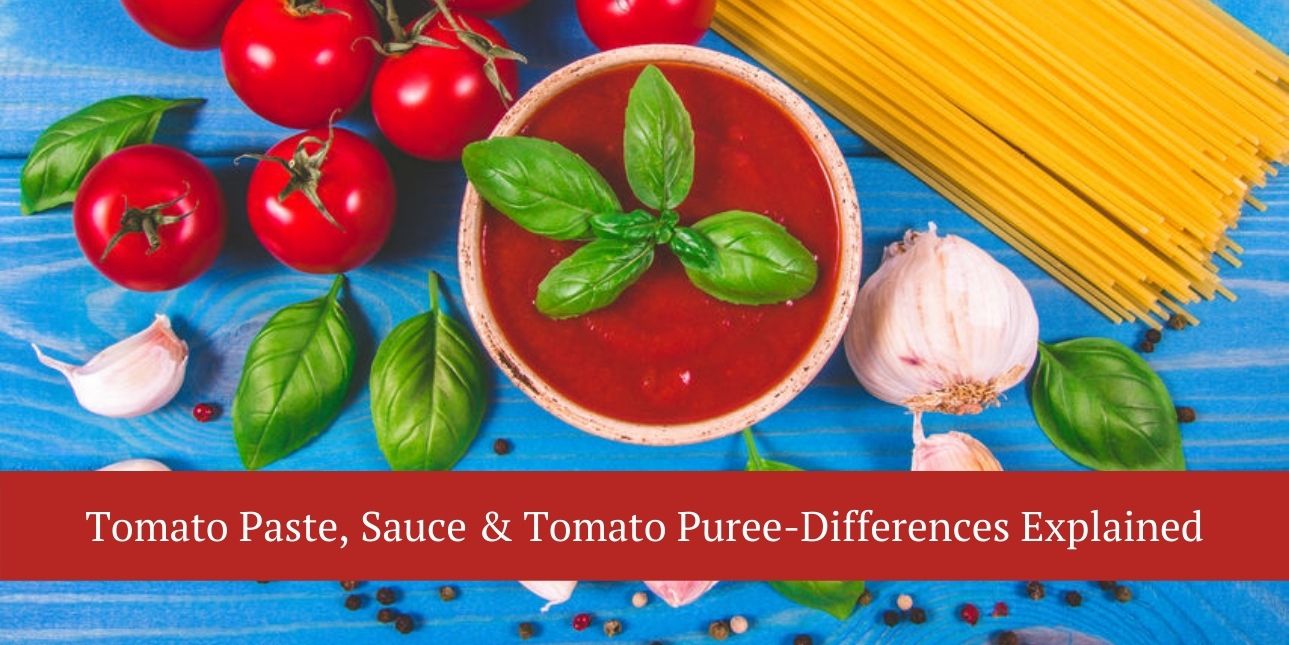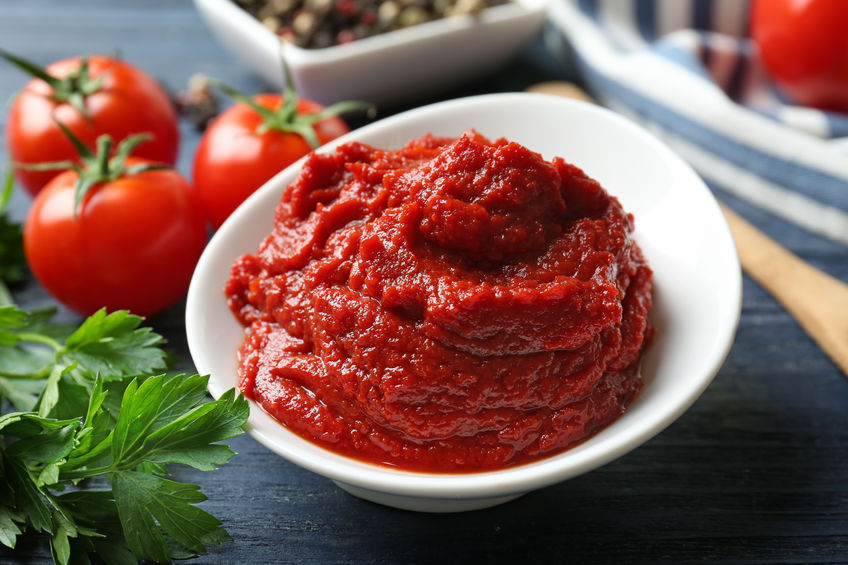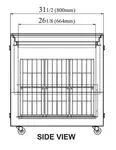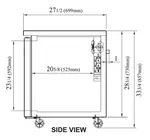Although they’re all tomato-based products, tomato paste, sauce, and puree are three different ingredients.
This article will explore each of the mentioned tomato-based products and the differences to help you identify what works best for your dish. We’ll also explore how to make tomato sauce from tomato paste and the ideal substitution for tomato puree.
What is Tomato Paste?
Tomato paste is a pantry staple made from tomatoes that have been slow-cooked, strained to remove tomato seeds and skin, and then cooked until it becomes a dense, paste-like concentrate.
The longer cooking periods also greatly enrich its flavor. This paste is commonly sold in tubes and cans and is quite thick, so a little goes a long way in every dish.
What is Tomato Puree?
Tomato puree is a thick sauce made by briefly cooking tomatoes, pureeing them, and then straining them to remove the tomato skin and seeds. To make tomato puree at home, peel and remove seeds from fresh tomatoes and then puree in a food processor. Homemade tomato puree without preservatives lasts about 15 days in commercial refrigerators and can last up to four months in a freezer.
What is Tomato Sauce?
At its most basic, tomato sauce is a thin sauce made by slow cooking fresh ripe tomatoes into a nearly liquid state with both the fleshy and juicy parts of the tomato. That is why, unlike smooth tomato juice, tomato sauce has an almost grainy texture. Tomato sauce is seasoned with spices, herbs, or veggies to enhance its taste.
To make tomato sauce at home, blend fresh ripe tomatoes, and then simmer the resulting sauce until it’s slightly thick. Alternatively, you can find it in your grocery stores. Both homemade and grocery-bought tomato sauce is good as long as you store it appropriately.
Tomato Paste, Sauce and Tomato Puree: What are the Differences?
Even though they all share a similar ingredient, tomato paste versus tomato sauce and puree have some pretty distinctions. Here are the detailed differences:
Preparation Method
The primary difference between tomato paste vs. sauce vs. puree lies in their preparation. Tomato paste, as mentioned, is cooked for longer periods than the other two. Preparation starts by first cooking the tomatoes, straining the resulting mixture, and cooking it again.
Tomato puree, on the other hand, is made by lightly simmering tomatoes and pureeing the resulting mixture into a liquid. Tomato sauce is made by liquefying whole tomatoes and then simmering until it’s slightly thick.
Texture and Consistency
Due to their preparation methods, tomato paste, sauce, and puree have a significantly notable difference in texture and consistency. Tomato paste has a thick, concentrated texture and remains firm even when placed on a pan.
Tomato puree has a thinner consistency and is more liquid-like. It quickly spreads out and forms a light, broth, or gravy-like mixture on an unheated cooking pan. Tomato sauce is similar to tomato puree but has a much thinner consistency and a grainy texture.
Flavor and Taste
Even though they are all quite flavorful, the flavor and taste between tomato puree vs. paste vary. Due to the additional cooking time, tomato paste boasts a more robust tang and umami taste and has a sun-dried tomato flavor.
Tomato puree starts from lightly cooked tomatoes, so it has a sweet, mild, and almost similar taste to fresh tomatoes. The tomato sauce variant has a nearly identical taste as puree but with a brighter acidic tomato taste and is more flavorful because it is pre-seasoned.
Uses
Since it’s thick and rich in taste, tomato paste typically thickens out soups and stews. It also gives them a richer color and enhances the taste. For instance, adding a spoon of paste to a bean stew deepens the flavor and makes it thicker.
Tomato puree is a common ingredient in tomato-based dips and sauces for delicacies like pasta and pizza. It’s also thinned out with vegetable, chicken, or beef broth in dishes that need a bright tomato flavor without the chunky texture of actual tomatoes.
Commonly used as a topping for dishes such as pasta or even in sandwiches, tomato sauce is the most versatile of the three options. When used in cooking, tomato sauce is pre-seasoned, so you might want to check the ingredient list to see if it’s compatible with your recipe.
Nutritional Content
The nutritional content in tomato paste vs. tomato sauce and puree is surprisingly different. A cup of tomato paste has 215 calories, 11.3 grams of protein, and 49.5 grams of carbs, while that of sauce contains 58.8 calories, 3.2 grams of proteins, and 14.1 grams of carbs. A cup of tomato puree contains 95 calories, 4.1 grams of proteins, and 22.4 grams of carbs.
How to Make Tomato Sauce from Tomato Paste
Here’s how to make tomato sauce from tomato paste.
• Mix one part paste and one part water until perfectly blended
• Slow cook garlic and onion until soft
• Add the paste and water mixture to the garlic and onions and heat through
For an authentic sauce taste, pre-season with ingredients you want in your dish. If you host many visitors or run a food business, you can make extra tomato sauce from paste and store it away in your blast chillers.
Substitution for Tomato Puree
If you have no puree for your sauce or barbeque dip, here’s what to use as a substitution for puree:
• Tomato sauce: Tomato sauce is the closest sauce to puree. But, tomato sauce is thinner than tomato puree, so you might want to cook it slightly to get an almost similar consistency to that of puree. Also, you may have to use twice as much tomato sauce to get that puree effect. Remember, sauce is pre-seasoned, so it might slightly alter your dish’s taste.
• Tomato paste: Paste also makes a good substitution for puree. To create puree from paste, all you need to do is add water. Only add a little as you don’t want the mixture to be all watery. Use 1/3 cup of tomato paste with 2/3 cup of water to create tomato puree. You can blend in a few tomato chunks with the mixture to enhance your homemade puree flavor and texture.
Happy Cooking
Tomato paste vs. sauce and tomato puree vs. paste is a real dilemma for most people. Hopefully, with our guide on their differences above, you’ll have an easy time selecting the suitable tomato-based ingredient for your dishes.

















